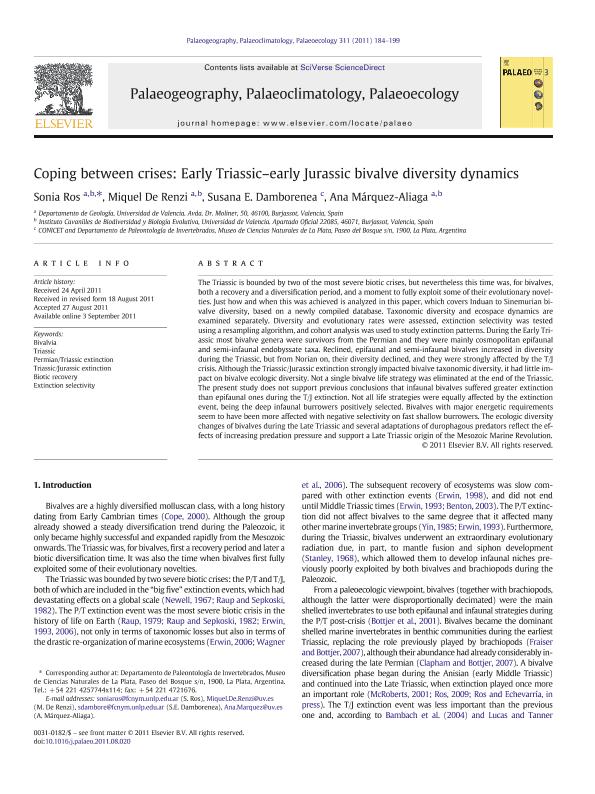Artículo
Coping between crises: Early Triassic-early Jurassic bivalve diversity dynamics
Fecha de publicación:
11/2011
Editorial:
Elsevier Science
Revista:
Palaeogeography, Palaeoclimatology, Palaeoecology
ISSN:
0031-0182
Idioma:
Inglés
Tipo de recurso:
Artículo publicado
Clasificación temática:
Resumen
The Triassic is bounded by two of the most severe biotic crises, but nevertheless this time was, for bivalves, both a recovery and a diversification period, and a moment to fully exploit some of their evolutionary novelties. Just how and when this was achieved is analyzed in this paper, which covers Induan to Sinemurian bivalve diversity, based on a newly compiled database. Taxonomic diversity and ecospace dynamics are examined separately. Diversity and evolutionary rates were assessed, extinction selectivity was tested using a resampling algorithm, and cohort analysis was used to study extinction patterns. During the Early Triassic most bivalve genera were survivors from the Permian and they were mainly cosmopolitan epifaunal and semi-infaunal endobyssate taxa. Reclined, epifaunal and semi-infaunal bivalves increased in diversity during the Triassic, but from Norian on, their diversity declined, and they were strongly affected by the T/J crisis. Although the Triassic/Jurassic extinction strongly impacted bivalve taxonomic diversity, it had little impact on bivalve ecologic diversity. Not a single bivalve life strategy was eliminated at the end of the Triassic. The present study does not support previous conclusions that infaunal bivalves suffered greater extinction than epifaunal ones during the T/J extinction. Not all life strategies were equally affected by the extinction event, being the deep infaunal burrowers positively selected. Bivalves with major energetic requirements seem to have been more affected with negative selectivity on fast shallow burrowers. The ecologic diversity changes of bivalves during the Late Triassic and several adaptations of durophagous predators reflect the effects of increasing predation pressure and support a Late Triassic origin of the Mesozoic Marine Revolution.
Archivos asociados
Licencia
Identificadores
Colecciones
Articulos(CCT - LA PLATA)
Articulos de CTRO.CIENTIFICO TECNOL.CONICET - LA PLATA
Articulos de CTRO.CIENTIFICO TECNOL.CONICET - LA PLATA
Citación
Ros, Sonia; De Renzi, Miquel; Damborenea, Susana Ester; Márquez Aliaga, Ana; Coping between crises: Early Triassic-early Jurassic bivalve diversity dynamics; Elsevier Science; Palaeogeography, Palaeoclimatology, Palaeoecology; 311; 3-4; 11-2011; 184-199
Compartir
Altmétricas




